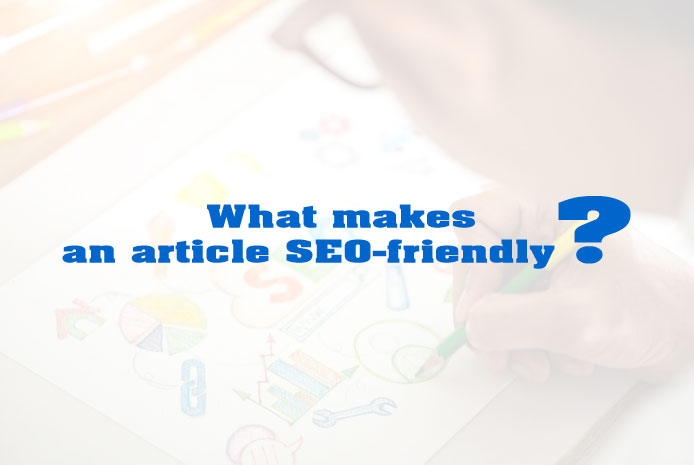What makes an article SEO-friendly?
- What Is an SEO-Optimized Article?
- Why Is SEO Writing Important?
- Basic Structure of an SEO Article - According to Viet SEO's experiments.
- Key Elements of an SEO-Friendly Article
- 1. Keywords
- 2. Heading Tags (H1, H2, H3...)
- 3. Content Length
- 4. Internal & External Links
- 5. Image Optimization
- 6. Keyword Density
- 7. Page Load Speed
- Important Notes When Writing SEO Articles
- 1. Write for Humans First, Not Just for Search Engines
- 2. Avoid Duplicate Content
- 3. Keep Content Updated
- 4. Use Natural, Friendly Language
- 5. Clear Call-to-Action (CTA)
- Recommended Tools for Writing SEO Content
- 1. Google Keyword Planner
- 2. Ubersuggest
- 3. Yoast SEO (WordPress Plugin)
- 4. Grammarly / Hemingway Editor
- 5. Google Trends
- Conclusion
What Is an SEO-Optimized Article?
An SEO-optimized article is a type of content that is specifically structured and enhanced to be search engine friendly — helping improve its ranking in organic search results on platforms like Google, Bing, and others. These articles not only provide real value to readers but also meet the algorithmic requirements of search engines.
In other words, writing an SEO-friendly article means combining SEO techniques with engaging content writing skills to increase visibility and attract potential readers.
Why Is SEO Writing Important?
In the digital era, where people tend to search for information through Google or other search engines, an SEO-optimized article can significantly increase your content’s visibility, drive targeted traffic, and enhance user engagement. According to VietSEO services, combining quality writing with smart optimization techniques is key to standing out in today’s competitive online landscape.
- Increase visibility: Optimized content is more likely to appear at the top of search engine results.
- Drive organic traffic: You can reach more users without spending a lot on advertising.
- Build brand credibility: High-quality content that ranks well helps build trust with readers.
- Convert readers into customers: Well-written SEO content can guide readers to take action (make a purchase, sign up, submit a form, etc.).
Basic Structure of an SEO Article - According to Viet SEO's experiments.
A proper SEO article should be clear, easy to read, and logically structured. Typically, it includes a compelling title, an engaging introduction, well-organized headings, keyword-rich content, internal links, and a strong conclusion. Based on best practices from Viet SEO agency, this structure not only improves readability but also helps search engines better understand and rank your content.
1. Main Title (H1)
- This is the most prominent title and should include the primary keyword.
- It should be under 70 characters.
- It should spark curiosity or directly address a “pain point” of the reader.
2. Introduction
- A brief overview of what the article covers.
- Should contain the main keyword or a variation of it.
3. Body Content
Divided into smaller sections with subheadings (H2, H3):
- Each paragraph should focus on one main idea.
- Include the main keyword, secondary keywords, and related (LSI) keywords naturally.
- Add images, examples, or tables when needed to enhance clarity.
4. Conclusion
- Summarizes the main points of the article.
- Includes a Call to Action (CTA): such as subscribing, sharing, commenting, or reading related posts.
Key Elements of an SEO-Friendly Article
To be truly SEO-optimized, an article needs to focus on the following aspects: relevant keywords, well-structured headings, internal and external linking, optimized images, and valuable content. According to VietSEO services, mastering these elements ensures your content not only ranks well on search engines but also provides a better experience for readers.
1. Keywords
- Primary keyword: Central topic of the article, appearing in the title, H1, URL, introduction, and throughout the content.
- Secondary & LSI keywords: Expand meaning, improve relevance, and avoid keyword stuffing.
2. Heading Tags (H1, H2, H3...)
- Help organize the content for both users and search engines.
- Make the article more readable and scannable.
3. Content Length
- Depending on the purpose, articles typically range from 1,000 to 2,500 words.
- Longer, in-depth content tends to perform better in rankings.
4. Internal & External Links
- Internal links: Link to other relevant articles or pages within your website.
- External links: Reference credible sources (Google, Wikipedia, research papers, etc.).
5. Image Optimization
- Use relevant illustrations.
- Name image files using keywords.
- Add ALT tags to describe the images for better SEO and accessibility.
6. Keyword Density
- Ideally between 1% and 3%.
- Avoid keyword stuffing, which can harm readability and SEO rankings.
7. Page Load Speed
- Faster load times keep readers engaged.
- Use optimized images, clean HTML code, and reliable hosting services.
Important Notes When Writing SEO Articles
Writing SEO articles isn’t just about inserting keywords—it’s about creating valuable, well-structured content that both search engines and readers appreciate. Based on insights from Viet SEO agency, paying attention to factors like keyword density, readability, content relevance, and internal linking can significantly boost your article’s performance and ranking potential.
1. Write for Humans First, Not Just for Search Engines
The content should be useful, easy to understand, and directly address the reader’s needs. Avoid forcing keywords in a way that feels unnatural or robotic.
2. Avoid Duplicate Content
Google penalizes duplicate or plagiarized content. Always aim to create original, creative, and valuable articles.
3. Keep Content Updated
Over time, update articles to match current trends, algorithm changes, or to include more accurate and relevant information.
4. Use Natural, Friendly Language
Keep your tone approachable. Depending on your target audience, choose a suitable voice: professional, conversational, humorous, etc.
5. Clear Call-to-Action (CTA)
Encourage readers to take action — read related content, make a purchase, comment, or share the article.
Recommended Tools for Writing SEO Content
To write more effectively, consider using these helpful tools for keyword research, content structure, and SEO analysis. At VietSEO, we often integrate these tools into our workflow to ensure every piece of content is well-optimized, easy to read, and aligned with search engine best practices.
1. Google Keyword Planner
- Discover relevant keywords in your niche.
- Estimate search volume and competition.
2. Ubersuggest
- Analyze keyword performance and get suggestions for related terms.
- Monitor content effectiveness over time.
3. Yoast SEO (WordPress Plugin)
- Real-time SEO checks while writing.
- Suggestions based on the latest SEO best practices.
4. Grammarly / Hemingway Editor
- Check grammar, spelling, and readability.
- Get suggestions for clearer, more concise writing.
5. Google Trends
- Track real-time search trends.
- Choose trending topics and hot keywords to attract more readers.
Conclusion
Writing an SEO-optimized article is no longer just a technical task — it’s the perfect blend of engaging content creation and smart SEO techniques. Referring to an SEO-Friendly Article Template can provide clear structure and guidance. A well-written SEO article helps you:
- Rank at the top of Google
- Attract consistent organic traffic
- Build credibility and increase conversions
If you’re just starting out, begin by researching the right keywords, writing valuable content, and practicing regularly. Over time, you’ll master the process and be able to create high-quality SEO articles that deliver long-term value for yourself or your business. With support from Viet SEO services, you can accelerate your learning curve and ensure every piece of content is strategically optimized from the start.



